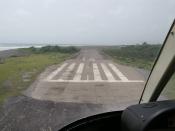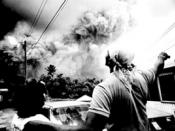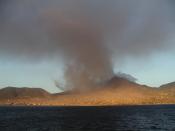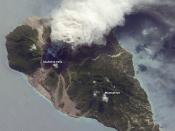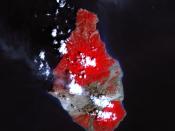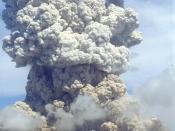Lithospheric Processes & Hazards àResearch ExcerciseSoufrière Hills MontserratThe Soufrière Hills is located in Montserrat isBritish overseas territory located in the LeewardIslands, part of the chain of islands called theLesser Antilles in the Caribbean Sea. It measuresapproximately 16 km long and 11 km wide,giving 40 km of coastline. Montserrat is situatedin the northern part of the Lesser Antilles,which is a volcanic island arc formed alongthe junction where the Atlantic tectonicplate is subducted beneath the Caribbean plate.
Nearly all the islands along the arc are the resultof subduction related volcanism. Most have (http://static.lonelyplanet.com/worldguide/maps/wg-montserrat-2233-400x300.gif)andesitic stratovolcanoes, which have been produced by explosive eruptions, coupled with the growth of lava domes and associated pyroclastic flows, and the occasional extrusion of lava flows. Montserrat was given its name by Christopher Columbus on his second voyage to the New World in 1493, after its namesake located in Catalonia. Montserrat is often referred to as the Emerald Isle of the Caribbean, due both to its resemblance to coastal Ireland and to the Irish descent most of its early European settlers (http://en.wikipedia.org/wiki/Montserrat).
What caused the eruption?The Caribbean island of Montserrat is situated on a destructive plate boundary. A plate boundary occurs when two of the plates that make up the surface of the earth meet. Underneath Montserrat the Atlantic plate is slowly being forced under the Caribbean plate. This happens because the oceanic plate is denser than continental plate. Convection currents pull the dense Atlantic plate into the mantle where intense heat and friction cause the rock to melt. This molten rock is lighter than the surrounding rock, forcing it to rise through cracks in the in the rock towards the earth's surface.
The Soufrière Hills Volcano produces thick sticky lava called andesite. The lava is so thick that it builds up at the top of the volcano in a dome until it becomes too heavy and the dome collapses. When the dome collapses hot rocks, gases and ash are released from the volcano causing the following hazards. Pyroclastic flows are extremely fast-moving flows of lava, hot rocks and gas that flow down the side of the volcano. Pyroclastic Surges are fast-moving clouds of hot ash that travel with the pyroclastic flow. Tiny pieces of volcanic ash are blasted into the air forming a plume of ash. As it cools down it falls back to the earth, covering vast areas with a layer of ash (http://www.bbc.co.uk/scotland/education/in/geog/envhaz/summary/flash_popup_vol_cause.shtml).
The current eruption of the Soufrière Hills Volcano started on 18 July 1995 and is still continuing in 2003. Throughout this time, the volcano has experienced different stages of eruption from earthquake swarms to explosive eruptions. On 25 June 1997 at about 1 p.m. the Soufrière Hills Volcano erupted catastrophically. The dome of the volcano collapsed, sending 5 million cubic metres of hot rocks and gases down the side of the volcano towards the north of the island. This signalled an increased period of volcanic activity and had a significant impact on the island.
What was the impact of the eruption?Impact on EnvironmentThe eruption on 25th June 1997 affected Montserrat in many ways by killing and injuring many people. Villages were destroyed; farms and farmland were covered in ashes deposits and rocks. During the eruption between 4 ÃÂ 5million cubic metres of lava was unloaded in theform of pyroclastic flows. A total of at least4 square kilometres of land was covered by thedeposits from the pyroclastic flows and surges.
The main part of the flow in Mosquito Ghautcaused intense scouring to the top of the valleywalls. Pyroclastic flow deposits completelyfilled Pea Ghaut. The villages of Farms andTrant's were completely buried by blockand ash flow deposits.
Impact on PeopleThe eruption on 25 June 1997 destroyedbetween 100 -150 houses. Most of the housesdestroyed were in the Exclusion Zone and shouldhave been empty but an estimated 15 people wereliving and sleeping in the Exclusion Zone. Most of the land suitable for farming was close by the volcano on the south and according to the reports there at that time there wasnÃÂt enough food supply going around so the locals put pressures on the officials to allow them for farming.
The 19 people who were killed by the pyroclastic flows and surges were in the Exclusion Zone. Common injuries to the seven people injured were severe burns to the feet as a result of walking on ash deposits only about 1-2 cm deep.. Other survivors suffered burns to various parts of their bodies, including inhalation injuries and burns to the nostrils and mouth (http://images.google.ch/imgres?imgurl=http://www.bbc.co.uk/scotland/education/int/geog/envhaz/images/volcanoes/cause/eruption/map_montserrat1.jpg&imgrefurl=http://www.bbc.co.uk/scotland/education/int/geog/envhaz/volcanoes/cause/eruption/eruption1.shtml&h=349&w=393&sz=31&hl=en&start=13&um=1&usg=__3hzY-qZPMPo6Nwf7vMw4DbzyKbI=&tbnid=iZepO07BcLQf2M:&tbnh=110&tbnw=124&prev=/images%3Fq%3DSoufri%25C3%25A8re%2BHills%2Bmap%26um%3D1%26hl%3Den).
What actions were taken before, during and after the eruption ?Before 25 June 1997 the British Government began to fund a temporary infrastructure in the north of the island including a jetty, roads, water and electricity. This development was extremely slow and the housing conditions were of a poorer quality than the local populations were used to. During this time the British and Montserrat Governments both adopted a 'wait and see' approach because the volcano had not been particularly active up until this point.
Actions taken by the MVO on 25 June 1997 helped to save lives. Continuous monitoring of the volcano enabled the scientists to predict that an eruption would be likely that day and evacuations of controlled areas within the exclusion zone were conducted successfully. Search and rescue teams were deployed quickly, enabling survivors to be picked up by helicopter or vehicle. Specialist medical support ensured treatment for burns victims.
After 25 June 1997 the volcano went through a period of violent eruption. The Exclusion Zone was extended and greater pressure was put on the remaining facilities in the North. The airport and the Plymouth port were closed and was destroyed by pyroclastic flows. The British Government finally agreed to fund a crisis programme of action (ã56 million) and to support development in the north of the island. Other Caribbean islands, organisations such as CDERA and the Red Cross also gave aid to Montserrat(http://www.bbc.co.uk/scotland/education/int/geog/envhaz/summary/popup.shtml?popup=volaction&popup=yes).
As recently as March 2003 the Soufrière Hills Volcano is still active and shows signs of slighlty increased activity. Lava dome growth, pyroclastic flows and rock falls are still being observed. As long as the volcano is active there can be no development or return to the south of the island (http://www.bbc.co.uk/scotland/education/int/geog/envhaz/summary/popup.shtml?popup=volaction&popup=yes).
Works Cited"The Government of Montserrat and the Montserrat Volcano Observatory." MVO. 11 July 1999. 20 Oct.
2008 .
"The history of Montserrat and the MVO." MVO. 20 Oct. 2008 .
"Soufrière Hills." Wikipedia. 15 Oct. 2008. 20 Oct. 2008 .
